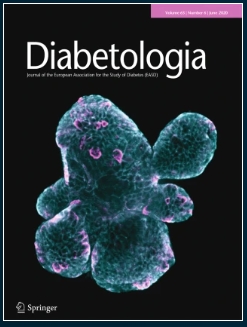Beyond pain relief: the effects of chronic opioid use on brain structure and function in diabetic neuropathy-a multimodal neuroimaging study.
IF 10.2
1区 医学
Q1 ENDOCRINOLOGY & METABOLISM
引用次数: 0
Abstract
AIMS/HYPOTHESIS Despite being commonly prescribed to treat painful diabetic peripheral neuropathy (DPN), the impact on the brain of long-term opioid use as analgesia is unknown. The aim of this study was to determine the structural and functional brain alterations associated with prescription opioid use in a large cohort of people with painful DPN. METHODS A total of 82 patients with diabetes were enrolled: 57 with painful DPN (18 with long-term opioid prescription [O+ individuals] and 39 who were not prescribed opioids [O- individuals]) and a control group of 25 patients with diabetes but without DPN (no DPN) matched for age (± 2 years), sex and type of diabetes. All participants underwent detailed clinical/neurophysiological assessment and brain MRI at 3 T, and a subset (14 in each group, n=42) also underwent resting-state functional MRI. RESULTS O+ individuals had greater caudate volume (ANOVA, p=0.03) compared with O- individuals (p=0.03) and those with no DPN (p=0.01). Functional connectivity was lower between the caudate and thalamus (r β = -0.24, seed-level correction -3.9, pFDR ≤0.05) in O+ individuals compared to those with no DPN. Moreover, seed-to-voxel analysis using caudate as the seed showed a significantly lower functional connectivity in O+ individuals compared with O- individuals in a cluster encompassing the superior frontal gyri bilaterally. CONCLUSIONS/INTERPRETATION We demonstrate that disruption of dopaminergic pathways occurs within the brain when opioids are used for analgesic purposes for painful DPN, which may reflect alterations in reward systems. This study has important clinical implications, as the measures of dopaminergic pathways found in this study may represent neuroimaging biomarkers that could be used to diagnose and monitor the negative consequences of prescription opioid use.一项多模态神经影像学研究:慢性阿片类药物使用对糖尿病神经病变大脑结构和功能的影响
目的/假设尽管阿片类药物通常用于治疗疼痛性糖尿病周围神经病变(DPN),但长期使用阿片类药物作为镇痛药对大脑的影响尚不清楚。本研究的目的是在一大批疼痛性DPN患者中确定与处方阿片类药物使用相关的大脑结构和功能改变。方法共纳入82例糖尿病患者:57例疼痛性DPN患者(18例长期服用阿片类药物[0 +个体],39例未服用阿片类药物[0 -个体])和25例年龄(±2岁)、性别和糖尿病类型匹配的非DPN糖尿病患者(无DPN)作为对照组。所有参与者在3 T时都进行了详细的临床/神经生理评估和脑MRI,并且每组14人(n=42)也进行了静息状态功能MRI。结果与0 -组(p=0.03)和无DPN组(p=0.01)相比,tso +组尾状核体积较大(方差分析,p=0.03)。与没有DPN的个体相比,O+个体的尾状核和丘脑之间的功能连通性较低(r β = -0.24,种子级校正-3.9,pFDR≤0.05)。此外,使用尾状核作为种子的种子-体素分析显示,在双侧额上回周围的集群中,与O-个体相比,O+个体的功能连通性明显较低。结论/解释:我们证明,当阿片类药物用于疼痛性DPN的镇痛目的时,大脑内多巴胺能通路发生破坏,这可能反映了奖励系统的改变。这项研究具有重要的临床意义,因为在这项研究中发现的多巴胺能通路的测量可能代表神经成像生物标志物,可用于诊断和监测处方阿片类药物使用的负面后果。
本文章由计算机程序翻译,如有差异,请以英文原文为准。
求助全文
约1分钟内获得全文
求助全文
来源期刊

Diabetologia
医学-内分泌学与代谢
CiteScore
18.10
自引率
2.40%
发文量
193
审稿时长
1 months
期刊介绍:
Diabetologia, the authoritative journal dedicated to diabetes research, holds high visibility through society membership, libraries, and social media. As the official journal of the European Association for the Study of Diabetes, it is ranked in the top quartile of the 2019 JCR Impact Factors in the Endocrinology & Metabolism category. The journal boasts dedicated and expert editorial teams committed to supporting authors throughout the peer review process.
 求助内容:
求助内容: 应助结果提醒方式:
应助结果提醒方式:


